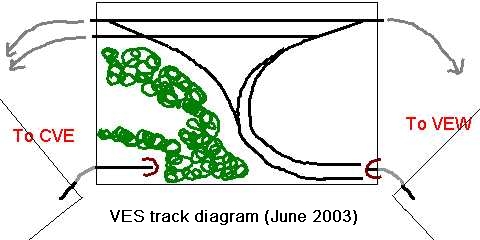The Val Ease Central Railroad ©Taking Z Scale to the Public Around the World |
| Now to come up with a plan that would add interest to the entire layout. What I had been hoping to add to VECRR was a a turning section, either a return loop or a wye. A return loop seemed a little too contrived in a point-to-point concept. I really didn't need to turn entire trains after all. A wye seemed much more interesting from an operational standpoint...if there was room for such a thing in the free space. It also seemed obvious to me that the wye should be on the upper level in order to turn locos operating at I.T.S. Mine. |
I'm happy to conclude that I stayed true to the goals for the module despite the many interruptions and distractions along the way. Credit to this success must go to the KISS principle of layout design...Keep it simple, stupid! This is a hard lesson to learn but it has always been right on the money. As soon as a project begins to become complicated, problems arise. The answer has always been to scale back the plans to a simple, straight forward and logical design. Works every time!
Have you noticed that no matter how limited the space one has to work with, it immediately expands to unlimited possibilities when the modeller is out shopping? I certainly have! The following quote shows the level of resistance I put up to facing the real limits to my track planning.
|
Later that evening, once back in the train room, I started laying track on top
of the suitcase with renewed zeal. I had a double slip that I wanted to work
into the plan too so I started to try new combinations. The railroad would
likely design a wye off of a siding to avoid tying up the mainline I reasoned.
OK, wye, siding, how about a hopper storage track as well? I was having a
great time!
|

The "almost final" VES track plan.
The "final" track plan looked terrific on paper but would only work in at least half again the space I actually had to work with. We all know now what VES ended up looking like. KISS to the rescue or "less is more"!
The great thing about a hobby like model railroading is that there are always opportunities to discover new techniques and new tools. While building VES I had the pleasure of working with a new tool, the Tippi Hot Wire Foam Cutter. It was fun playing with the tool, seeing how easy and time-saving it was to carve a variety of shapes and textures. It was especially satisfying watching the foam pile up on the floor as I roughed out the cuts and the mountain contours. The little strings that the tool made when finishing a cut reminded me of Christmas decorations.
In terms of techniques, it was fun to "make-a-lake" after so many years. There is always a sense of anticipation when waiting for the acrylic medium to dry over night. Seeing the result the next morning was like opening a present.
The only thing that I changed in terms of styrofoam building techniques was using tacky acrylic craft glue to permanently attach the multiple layers of foam. Normally I would have used rubber cement but there was simply too much material to glue.
VES forced me to burn up a large number of little grey cells trying to find solutions to a variety of design challenges. Frankly, I am very happy with my imagneering efforts, such as the mountain-in-a-hole, the tree plantation, the quarry and the module wiring solution.
Once the design is determined, layout building can take place rather quickly depending on unforeseen obstacles. Fortunately, the advantage of a modular approach to layout construction is that work on a particular module can take as long as necessary without any significant impact on the remainder of the layout.
Another advantage of layout building is that progress is not a function of availability of materials. What held me up were motivation and inspiration lapses. Z is no different than any other modelling scale in that inspiration = 90% perspiration, that is, it is often only when one is confronted with a specific building challenge that potential solutions begin to present themselves. Patience is a pre-requisite for "successful" layout design and construction. Success is no sure thing and may take several attempts to achieve.
VES was my first experience writing a construction blog. I have often broadcast daily field reports from train shows but never detailed every step along the way to completion of a project. The feedback I received from fellow "Valeasians" was critical to keeping me on track and helping to recharge the batteries. Telling the "VES story" became an important aspect of the project, at times even surpassing the modelling activities, especially when I was short on ideas concerning design problems.
Sharing my thought processes, problems and solutions was the most FUN of this project. Thanks for joining me in the VEC Library and on the journey to the "Summit".